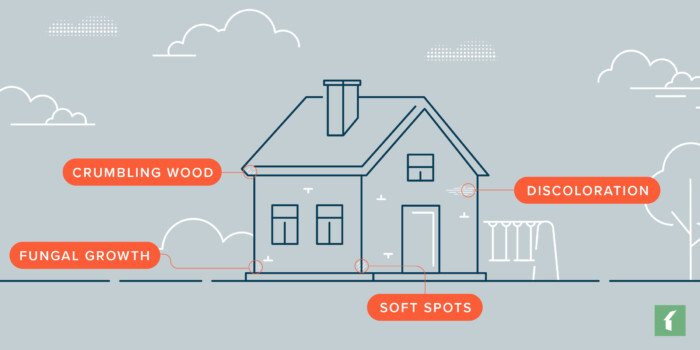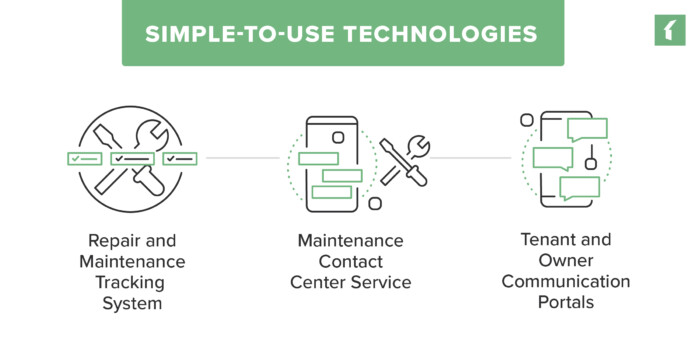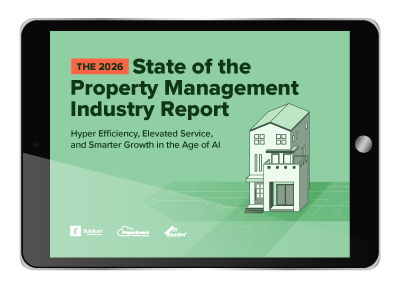Even if your properties haven’t experienced an especially cold winter, you’ll want to use this time to prepare for whatever weather events lies ahead, be those heavy rains, the beginning of drier wildfire-prone months, or tornado season.
Automated Maintenance
Track every maintenance request, schedule repairs, and pay vendors all in one place.
Learn MoreUse this home maintenance checklist to prepare your properties for the months ahead, make any repairs caused by the past season, and get ahead of common maintenance issues in the spring and summer.
Want to get started? You can download the full Spring Rental Property Maintenance Checklist at the top of this post.
Why Spring Rental Property Maintenance Is Important
Spring property maintenance prevents costly repairs and protects property value by addressing winter damage before it worsens. This seasonal upkeep helps property managers catch issues early, prepare for summer weather challenges, and maintain tenant satisfaction through proactive care.
Of course, if you’ve winterized your property last season, much of this checklist will be a walk in the park.
Common Maintenance Issues Property Managers Face
A proactive maintenance plan starts with knowing what to look for. While every property is different, certain issues appear more frequently than others. Keeping an eye on these common problem areas helps you catch small issues before they become expensive emergencies.
The most frequent maintenance issues include:
- Plumbing problems: Slow leaks that can lead to significant water damage; the EPA notes that a key sign of a serious leak is if a family of four’s winter water use exceeds 12,000 gallons per month.
- HVAC system failures: Equipment breakdowns during peak seasons
- Appliance malfunctions: Refrigerators, washers, and other tenant amenities
- Pest infestations: Seasonal increases in insects and rodents
- Roof and gutter damage: Issues caused by winter weather and storms
By anticipating these repairs, you can schedule preventative checks and keep your properties in great condition.
Understanding Maintenance Responsibilities and Legal Requirements
Clear maintenance responsibilities are foundational to a good owner-tenant relationship. Your lease agreement should plainly state which tasks fall to the tenant and which are your responsibility. This clarity helps prevent disputes and sets clear expectations from the start.
Typical responsibility breakdown:
- Tenant responsibilities: Routine cleaning, changing light bulbs, basic upkeep
- Property manager responsibilities: Plumbing, electrical, HVAC system repairs
As a property manager, you must also follow all federal, state, and local laws regarding property habitability. These laws require you to maintain a safe and livable environment for your residents. Staying informed about these requirements protects your business, your owners, and your residents.
Building Exteriors
Let’s start with the upkeep and repair of the first thing people see—the exterior of the property. From roofing to the walls, windows, doors, and foundation, your exterior is crucial to preserving not only your property’s curb appeal, but also its structural integrity.
Walk around your property and take note of any glaringly obvious fixes like peeling paint, damaged windows, or any cracking in your masonry. Then start a more thorough inspection that includes these tasks.
1. Inspect the Roof for Damage
High winds can loosen the shingles on your roof, which opens up an unwelcome opportunity for moisture and pests to make their way into the underlying wood sheathing. Thoroughly inspect your roof to avoid unexpected new tenants like raccoons, squirrels, mice, termites, bees, wasps, and carpenter ants.
2. Clear the Gutters
Gutters are responsible for redirecting water away from the foundation of the building, and can easily get clogged by ice, snow, leaves, and dirt. This may cause an overflow that may damage your siding and foundation.
The heavy weight of ice and snow in particular is a common cause for gutter gaps to break. Clear out any debris and check your gutters are free from rust or corrosion. Ensure that they’re also properly aligned and are sloping downwards to properly redirect runoff. Just like roofing, pests and critters can claim the clogged gutters as their homes, which may be costly to fix down the line.
3. Check for Wood Rot
Inspect all your wooden surfaces, like your decks, sidings, foundation posts, and porches for any signs of rot, decay, or insect damage. Here are the most common ways to check for wood rot:

- Look for discoloration in wood, which often looks darkened or has turned from light brown to black.
- Feel for soft spots. If the wood feels spongy when pressure is applied, there may be wood rot. Splits and cracks may also be a sign.
- Identify small mushroom-like growths that may be fungal growth.
- Run your screwdriver or knife along the surface of the wood. If the wood begins to crumble, or is easily penetrable, wood rot may be present.
4. Maintain Your Walls, Steps, Windows, and Sidewalks
Power wash your walls, steps, and sidewalks to remove any leftover grime, dirt, or debris that may have accumulated from sleet or snow. Repair any cracks or damages to the walls, sidewalks, or steps that may have been a result of freezing and thawing during the colder months. Consider painting the exterior if there is any major discoloration from winter precipitation.
5. Recalk Doors and Windows
Gaps in windows are also susceptible to freezing and thawing throughout the winter, potentially causing air leaks. Inspect the caulking around your doors and windows for any gaps, cracks, or signs of leaks and replace any damaged caulking with new caulk or weatherstripping.
This will ultimately reduce the heating or air conditioning needed in the warmer months and save energy, as improper HVAC installation alone can increase household energy use by around 30%. It also doubles as a great opportunity to check and replace your window screens as necessary.
If you’re in a tornado-prone area, consider investing in storm shutters and impact-resistant windows and doors, including garage doors, which are a common weak spot in a property’s defense against tornadoes.
6. The Final Walkthrough
Take a look at your outdoor furniture that may not have been put away. Replace any dead light bulbs in your backyard and check on any CCTVs you may have on the premises. Pay attention to the lawn, allowing grass to grow two to three inches tall to promote more drought-resistant lawns, and trim any bushes or trees that are hanging over your home and may damage your property. Lastly, remove any fallen branches or debris that may have not been removed yet.
Note: If your property is in a tornado or fire-prone area, take extra care to clear your exteriors of any hazardous debris, overgrowth or other material. Be sure to fasten down any heavier outdoor furniture that can pose an additional risk in high winds.
Building Interiors
Now let’s take things inside. It’s important to conduct regular checks in the interior to improve or maintain good air quality, save energy, increase safety, and extend the lifespan of your appliances.
1. Filters and Air Units
A great place to start is by vacuuming or replacing air filters in your heating and cooling systems to ensure optimal air quality, and also checking for issues like leaky air ducts, which research shows are a dominant fault responsible for increased energy use. Inspect the coils in the back of the fridge and wash or replace the fume hood in the kitchen. These are susceptible to being clogged up over time. Check on your A/C units that have been stored away during the winter and ensure they’re in good working order. This is also the perfect time to inspect your furnace filter and replace it if needed.
2. Spray for Pests
Checking for pests should be a year-round practice, but since they’re more likely to come out of hibernation and reproduce in warmer months, take extra care when looking for signs of any uninvited guests.
Hire a pro to come in and spray for ants, spiders, and other seasonal pests. Look for cracks and spaces where pests could get in and seal them. Check your home’s basements, attics, crawl spaces, and areas with water sources like kitchens and bathrooms.
To save time and ensure you’re not missing any red flags, hire a professional you trust to conduct a thorough inspection and treat the property to address the issue swiftly.
3. Scope Out Plumbing Problems
Proactively preventing any plumbing problems will save you a fortune on serious repairs. A sudden change in temperature is a leading cause for irrigation problems, so start by checking the water and drain lines and look for signs of corrosion. Check water lines under the sink in the kitchen and make sure there’s no discoloration. When inspecting any plumbing section, be sure to check pipes and hoses for cracks that indicate an impeding issue.
Turn on all your faucets and make sure the water temperatures, pressure, and drainage are suitable. Test the pressure with a pressure gauge if it seems too low or too high—which may reveal potential clogging or pipe damage—as fixtures operate best with incoming water pressure between 45 and 60 pounds per square inch (psi).
Hot water tanks are susceptible to sediment build up as well. Drain the sediment and reset temperature gauges as needed to improve the longevity of your water heater.
4. Check Smoke and Carbon Monoxide Detectors
Your checklist should also include checking your smoke and carbon monoxide detectors to confirm they are functioning correctly. Test the button on each detector to ensure the alarm sounds and check and replace the batteries (this should be done yearly, even if they haven’t expired). Have backup batteries on hand for detectors that are hardwired into your home’s electrical system.
You should also check the exterior of each detector for any visible signs of damage or obstruction that could impair its function. You can even use a vacuum cleaner’s soft brush attachment to gently remove dust from the smoke detector’s exterior vents. Dust can prevent the detector from working correctly.
Budgeting and Cost Management for Property Maintenance
Effective maintenance is not just about fixing things; it is also about managing costs, and investing in water-efficient fixtures can lead to significant savings, with some families saving over $700 in water and energy costs per year. A well-planned maintenance budget protects your owners’ investments and your own profitability.
Key budgeting strategies:
- Routine maintenance fund: Set aside money for predictable seasonal tasks
- Emergency repair reserve: Maintain funds for unexpected issues
- Expense tracking: Use software to monitor costs by property and vendor
- Trend analysis: Review data to negotiate better rates and improve budgets
When you can show owners a clear, data-backed approach to cost management, you build trust and demonstrate your value.
Let Your Residents Be Your Watchful Eyes
The best way to stay on top of property maintenance is to engage with your residents to identify potential issues as they occur. Having an open line of communication helps you avoid surprising headaches during inspections. The right technology makes it easy to communicate with tenants and keep work orders organized.

Repair and Maintenance Tracking System
Maintenance tracking software enables residents, owners, and employees to submit work orders, upload videos, and documents to request work orders. It will also allow you to schedule recurring items, including this maintenance checklist so your vendors can stay on top of regular check-ups. You can even group related spring maintenance related tasks and their corresponding work orders into projects making them easier to manage and track the progress of.
Through Buildium’s Property Meld integration, automated workflows and automatic troubleshooting streamline maintenance and reduce manual follow-up, helping staff focus on higher-value work.
Maintenance Contact Center Service
A Maintenance Contact Center can also help service and manage requests at all times – even when you’re asleep. It’ll help you keep up with the flow of your incoming maintenance calls, give your residents access to every ticket in real-time, and provide highly trained support to help resolve issues.
Tenant and Owner Communication Portals
Above all, a resident portal makes it easy to stay in sync with your residents and stay on top of your property maintenance. This is the ideal place to post alerts for any upcoming inspections, important safety protocols for seasonal or weather-related risks, and keep your tenants informed of upcoming work.
In an all-in-one portal, residents can track maintenance requests, send text and email updates, and ultimately have a two-way record of any ongoing issues that may arise. You can send out updates to entire communities and HOAs or keep individual tenants informed with the same level of ease.
Making Spring Maintenance Work for Your Growing Portfolio
A systematic approach to spring maintenance does more than just protect property values; it builds a more resilient and scalable business. When you handle maintenance proactively, you show owners that you are a responsible steward of their assets and give residents a safe, comfortable place to live.
By organizing your workflows and using the right tools, you can manage more properties without letting quality slip.
Remember these key takeaways:
- Schedule seasonal inspections to catch winter damage before it escalates into costly repairs.
- Focus on common problem areas like plumbing, HVAC systems, and roof damage first.
- Use maintenance tracking software to streamline work orders and communicate with residents effectively.
- Budget 1%–4% of property value annually for maintenance with seasonal adjustment flexibility.
If you’re ready to organize your maintenance processes and prepare your business for growth, you can test out Buildium’s features with a free 14-day trial or by signing up for a guided demo.
Frequently Asked Questions About Rental Property Maintenance
What is considered a maintenance expense on a rental property?
Maintenance expenses typically include costs for repairs and upkeep required to keep a property in good condition. This includes tasks such as plumbing repairs, HVAC servicing, pest control, landscaping, and fixing broken appliances. These are distinct from capital improvements, which add value to the property.
What does comprehensive property maintenance include?
Comprehensive maintenance covers a wide range of activities. It includes routine inspections, preventative care for systems such as HVAC and plumbing, seasonal preparations for exteriors and grounds, pest control, and responding to repair requests from residents in a timely manner.
How often should I conduct seasonal maintenance inspections?
Plan seasonal maintenance checks at least in spring and fall (e.g., HVAC pre‑season inspections and exterior checks), with the scope adjusted to your property’s age, climate, and risk profile.
How much should I budget for spring property maintenance?
Budget roughly 1%–4% of the property’s value annually for maintenance (older properties may need more). Expect seasonal spikes (often spring or winter depending on climate), but avoid assuming a fixed 25%–30% allocation to spring tasks.
Read more on Maintenance

